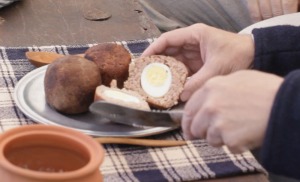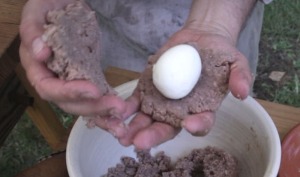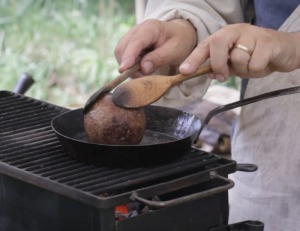If you’re trying Scotch eggs for the first time, you’re in for a treat! A popular snack food in the U.K., Scotch eggs can be found there in grocery stores, gas stations, and everywhere in between. I had my first Scotch egg about 10 years ago at a local British-style pub. They are a guilty pleasure of mine, with which considerable discipline must be exercised to eat them in moderation. While Scotch eggs may not share the British prestige of officially protected geographic status like a Buxton blue or a Melton Mowbray pie, they are still clutched close to the heart by many adoring fans…which is where I always kind of envision them resting as I eat them, bypassing the stomach altogether.
The first Scotch egg is claimed to have been invented by a London department store in the late 1730’s, however, some believe they may have been adapted from much older Moghul dishes. The version we presented in our video was our take on Maria Rundell’s rather ambiguous recipe that was first published in her 1808 cookbook, A New System of Domestic Cookery.
Forcemeat was typically any type of finely minced and seasoned meat, that was either formed into balls and used as a garnish for other dishes or as an addition to soups, or it was used as a stuffing. It was also prepared as a dish in its own right. The list of possible ingredients in forcemeat is so long, that the term is probably better used to refer to the technique of making it as well as its varied use rather than its specific ingredients. Some 18th century recipes for a forcemeat for poultry, for instance, was nothing more than what we would call a bread dressing or stuffing. So forcemeat didn’t even have to have meat in it to be called forcemeat.
There are few precise forcemeat recipes in the period cookbooks. Usually the authors gave wide berth for individual taste preferences. In an earlier section of her duodecimo, Rundell stated that “Exact rules for the quantity cannot easily be given; but the following observations may be useful, and habit will soon give knowledge in mixing it to the taste.” She then provides a list of ingredients from which to choose (see below). The column on the left contains four necessary ingredient categories: meat, fat, basic seasoning, and a binder. The column on the right are her suggested additions to really spice it up a notch.
So with our version, we followed her advice by letting ham be the predominate meat. We did not follow her advice, however, on the addition of fat. Some cookbooks indicate that lean meat should be combined with either suet or bacon fat — some recipes suggest in equal proportions. Pulverizing the meat with the fat is frequently recommended. Without the added fat, we found that pulverizing was absolutely necessary. If you attempt to do this with diced ham, it likely won’t adhere to the boiled egg. If you wish to pulverize your ham in a mortar and pestle, more power to you! If you’re making these at home, I suggest you plug in your food processor instead. Use a half pound of ham. [Contrary to what we said in the video, we mistakenly used a full pound. We were eventually forced to add another egg yolk along with a little editing magic.]
We seasoned our ham with about a half teaspoon each of allspice and nutmeg, a quarter teaspoon black pepper, and a dash of salt. In addition, we added 1/4 cup finely grated bread crumb and the yolk of one egg. If your meat doesn’t hold together well or adhere to your boiled egg, add another egg yolk (like we did off-camera).
Once your meat mixture is mixed well, make a couple of patties, and then place a peeled boiled egg in between the patties. Some people like their eggs soft-boiled, others hard — your choice. For a good article on how to boil the perfect egg, click here. Press the patties together, completely surrounding the egg. You’ll want about 3/8 to 1/2″ of meat surrounding the egg.
At this point, you can also roll the Scotch egg in additional bread crumb if you wish. Our friend, Michael, chose to pan fry his Scotch eggs on a brazier. The ham was already fully cooked. You can also deep fry Scotch eggs, which is how I have always had them.
Don’t forget the gravy!
Scotch eggs are traditionally served with a gravy. A very basic period-correct version goes as follows: form a ball of butter about the size of a walnut, and roll it in flour to coat it well. Place this in a hot skillet, being careful not to shake off any excess flour. When your butter is melted, but before the flour browns, add a little milk or cream, along with a little chicken stock. Season with salt and pepper, and any other seasonings you may prefer. Stir over medium heat until the gravy thickens.





Reblogged this on Paleotool's Weblog and commented:
My favorites!
They are very good.. I had them at the Texas Renaissance Festival last October….
Pingback: Scotch Eggs | Savoring the Past | Technoprimitive 3
Pingback: Merkwaardig (week 27) | www.weyerman.nl
I have seen Scotch Egg recipes before, but your blogpost and video make it clear finally! A big meatball, about the size of an Italian arancini, with a boiled egg in the center. The twist is that you can use any meat you care to grind up!
Thanks!
Looks interesting! At first I thought it was in bread.